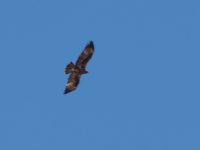I saw this bird far, always flying away from me, so I couldn't get a fair front view (impossible to see any white shoulders). The photo is a little bit crappy, result of finding no batteries inside the camera and getting a bit nervous trying to put one inside, after a very brief and far view with the binoculars.
In the field I didn't get in any moment the feeling of lightness that Goldens usually transmit to me, the tail seemed short and wings not pinched near the body. Also the very pale inner primary seen perhaps fit better SIE
The area is dominated by Goldens, and as far as I know there are no SIE adults around, but they are slowly and steadily colonising the area. In fact less than an hour after I saw a ¿2 cy? Imperial about 10 km from this eagle.
So although Golden is more possible I'm now a little bit more in the Spanish Imperial side (5-6 cy?) but would like to have another ideas. Is it possible to say more than Aquila sp?
In the field I didn't get in any moment the feeling of lightness that Goldens usually transmit to me, the tail seemed short and wings not pinched near the body. Also the very pale inner primary seen perhaps fit better SIE
The area is dominated by Goldens, and as far as I know there are no SIE adults around, but they are slowly and steadily colonising the area. In fact less than an hour after I saw a ¿2 cy? Imperial about 10 km from this eagle.
So although Golden is more possible I'm now a little bit more in the Spanish Imperial side (5-6 cy?) but would like to have another ideas. Is it possible to say more than Aquila sp?






